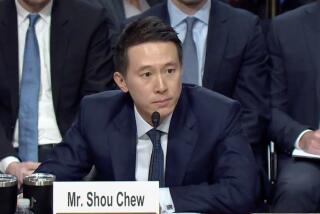Op-Ed: Twitter users requested less trolling. Instead, we got tweet weight gain

Prosody, the rhythmic structure of verse, is not logical. That’s why we speak of rhyme as the opposite of reason.
Nor was Twitter’s first 140-character limit for tweets ever logical.
Jack Dorsey explained this at tedious length on Twitter on Tuesday, when the venerable microblogging platform announced that it was fully doubling the character limit on tweets, from 140 to 280.
Part of Dorsey’s rambling 280-character explanation for the change was that the original decision to keep readers to 140 characters was “arbitrary.” It was, he went on, borne of the 160-character limit on SMS texts. Twitter cut this number by 20 to make space for user names, which — as Biz Stone further elaborated in another 280-character tweet — meant that Stone, with the three-letter handle @biz, got one more character than @jack did, and so they...
Twitter might have introduced tighter regulation rather than looser character limits.
Zzzzzz. Sorry? Forehead-keyboard for a minute there. TL; DR: Twitter is now letting tweets run to 280 characters.
Twitter users had requested less trolling. They had pleaded for no bots. They had begged for fewer Nazis. Instead, we got tweet weight gain — surplus characters no one asked for.
Why “surplus,” though? Why isn’t this just mom and dad building a welcome addition on a one-bathroom tract house? Because, however arbitrary Twitter’s original 140-character limit, when the tweet and its limitations appeared in 2006, it forced a new kind of poetic inventiveness. And this epigrammatic, aphoristic style was inspired — as usual in all literary genres — by the necessity imposed by the materials used for writing. Papyrus, skywriting, newsprint, billboards and neon all have constraints that give rise to particular modes of expression. So does computer code.
Think that real poetry wasn’t forged in fires as arbitrary as SMS limits?
In the 20th century, the New Yorker started publishing poetry against cartoons, tight columns of prose, and small boxy ads. It couldn’t very well fit lyric epics, so it had to give preference to what we might now call short-form verse. Goodbye to the expansive lines that permitted Walt Whitman to contain multitudes. The New Yorker awarded publication to poets who wrote in a way that fit its format, in the succinct-no-filler, “lapidary” style, in which each word was meant to seemed etched, as if in stone. Then that style, as Whitman’s style before it, came to define an important strain of American modernist poetry.
Over time, the New Yorker’s lapidary lyrics, determined by the exigencies of the magazine’s cartoons, ads and 8.5” x 11” size, seemed entirely logical and singularly suited to the rhythms of the modern American mind. Much the way tweets, for better or worse, seem uniquely equal to contemporary needs.
There’s nothing organic about journalistic forms, either. Think about how much of newspaper-storytelling has to do with the need to have a good headline that can fit on the cover and scream out to passersby from a newsstand. A tabloid editor might dream up the cruel pun “Christie Wrinkly” and then order a reporter to whip up some text that could fit the joke, working backward.
So, Twitter, who cares if your original 140 was arbitrary? Sure, some people saw the birdbrained 140 and said it trivialized thought; they stuck to email and Facebook posts. (Likewise, even after Snapchat and Pinterest appeared, I stuck to Twitter; we’re all captivated by different forms.) But we who cottoned to Twitter jumped in for the forced corseting — and not in spite of it. While nobler scribes derided Twitter as more Adderall for the uncouth — just as the 1st century scribes had believed the 1st century Roman “books” were barely literate — those of us who started experimenting with Twitter a decade ago learned, over time, to tailor our idiom to it. We simultaneously studied and invented Twitter’s pace, flourishes, ciphers, set pieces and semi-private jokes around its constraints.
As William Gibson, the august sci-fi novelist, put it Tuesday: “Brevity’s been the soul of Twitter, for me. The 140-character limit has been a master class in concision and economy.”
Of course, users always cry in agony when there’s an “upgrade” to beloved software. And Twitter users are wily. They’re used to being pushed around, too; the sometimes-bruising Twitter life is not for everyone. No doubt tweeters will adjust to the flabby 280 — and probably even find crafty ways to exploit it for humor, cultural commentary and new kinds of op-eds. It wouldn’t be the first time writers have customized Twitter’s capricious rules.
Just this year, political Twitter wrested a brave new genre out of the interface — “threading,” which cunningly illuminates social problems and the Trump catastrophe. The best practitioners of this form — experts in constitutional law or the FBI’s modus operandi — stack tweets to create a lecture, explainer or op-ed in bullet points. (For anyone despairing about media or social media, the rise of these incisive threads has been a reason for hope.)
So Twitter will survive. But right now, when trolls and bots rampage through it, intent on crushing individual spirits and threatening democracy, Twitter might have introduced tighter regulation rather than looser character limits. That would have been nice. And would have sufficed.
Virginia Heffernan cohosts the “Trumpcast” podcast and is the author of “Magic and Loss: The Internet as Art.”
Follow the Opinion section on Twitter @latimesopinion or Facebook.
More to Read
A cure for the common opinion
Get thought-provoking perspectives with our weekly newsletter.
You may occasionally receive promotional content from the Los Angeles Times.






